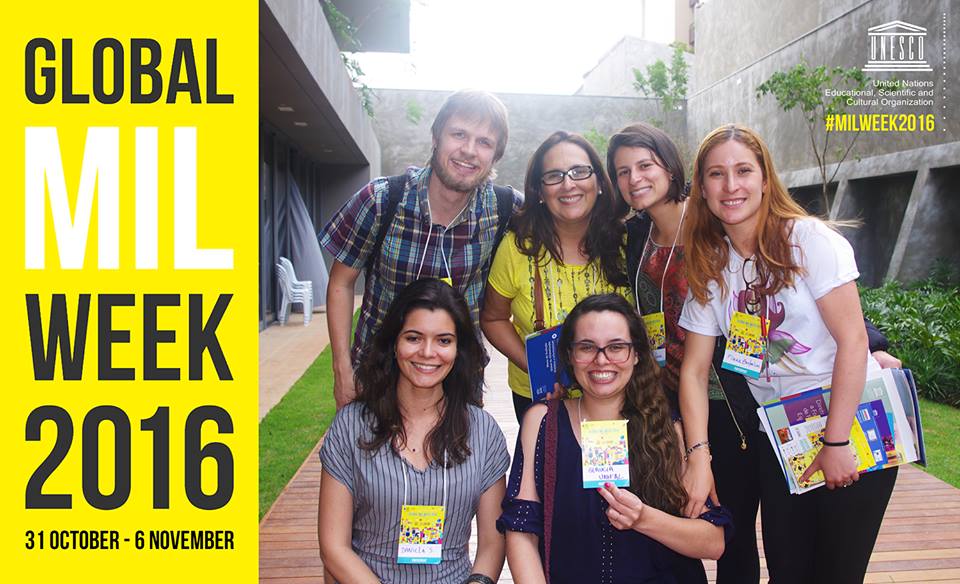With over 150 participants present at the kick start of the Youth Day on Wednesday, November 2nd, the UNESCO’s Global MIL Week 2016 celebration officially started in Sao Paulo, Brazil. Throughout two discussion panels young people spoke to youth and adults and engaged in a series of workshops on Media and Information Literacy (MIL). The first day of the Feature event of the Global MIL Week focused on critical thinking for youth and “hands-on” practical experiences.
Critical Youth Engagement
At the first discussion panel young people shared innovative projects and experiences in production of information and media content for advocacy and positive social change. Ms. Adama Lee-Bah, Head of the Youth Sub-Committee of the Global Alliance for Partners on MIL (GAPMIL), in her opening remarks commended UNESCO for ensuring that youth plays a central role in the operation of GAPMIL. A dynamic young presenter, Ms. Eylam Leshem, member of the UNESCO-European Commission NET-MED Youth Working Group in Israel, shared the iThink a mobile application. This app helps people make informed decisions, which is part of MIL, through providing proposed legislation accessible, allowing people to directly vote and and express their opinion regarding individual bills, amendments and procedures.
Youth leader, Mr. Abrahim Simmonds, Executive Director, Youth Empowerment through Culture, Arts and Nationalism (JAYECAN) noted that true empowerment comes through helping young people to realize and operationalize their inner resources and environment to make their own lives better, and MIL is a set of skills and competencies vital to this process.
Various ways of teaching MIL
Workshop “Thinking about new and innovative tools to promote Media and Information Literacy” from NET-MED Youth Project discussed various methods of teaching MIL. “The NET-MED Youth project has helped me develop skills and abilities to distinguish between media affiliated to certain interests and independent media by using mechanisms to analyze content, topics and speakers. This contributed to transform me from being only a recipient of information, to interacting with it. It has equipped me to not simply accept everything that is displayed on the screen as facts, but to work on criticizing and analyzing the content, and then accept it or not” said Sondos Faqeeh from Palestine.
Comment boxes as spaces for arguments
In another workshop the participants offered their opinions how can communication be improved. “Here in Brazil the comment boxes on social media or newspaper websites, let me put it in the metaphoric words expressed by participants, are the place to vomit. We wanted to create an app to make people see news in context, how each article is part of the bigger context and think more how to connect the dots. Participants tried out the app and we received great feedback from them” said Jessica Tarasoff, workshop leader from the University of Sao Paulo.
Music as a way of teaching MIL
Telefonica Digital Education focused on music; Referencing to a recent Nobel prize recipient Bob Dylan who used his medium to get his literacy across, participants gathered in the workshop “Maker Experiences, MIDI Controller and 3D printing” assembling a music controller through both hardware and software.
Using apps to learn about different cultures
Creating a situation where critical thinking and creative answers are required is a start for any kind of development and learning process about MILs. Technology can contribute to this “The workshop “Learning to learn with technology” engaged participants to learn about each other’s cultures using creative techniques, as well as to learn in more dynamic ways. “People are using this application to integrate different means of technology – everything from taking photos to doing videos to learn about each other” explained Mr. Jonas Sylvester Kaspersen, director of Organisational Development at Recrear International and workshop leader”.
Critical engagement and Non-violent communication
Recognizing violent elements in a media content was targeted in the workshop “Press, Violence, Youth: Tools for News Literacy” organized by different departments at University of Sao Paulo (USP). “We learned a lot about non-violent communication, and it was very important to see a lot of different aspects that make our communication violent and what can we do to have dialogue instead of sometimes just screaming at each other or voicing of opinions and not listening” said Ms. Julia Showlia from Sao Paulo who took part in a workshop.
“Media and information literacy starts with me”
It became easier than ever to voice opinions at all levels – locally and globally. But as UNESCO’s Alton Grizzle emphasized, no matter what is the method, the key lies within critical thinking. Stakeholders around the world recognize the need for critical youth engagement to achieve sustainable development. Online spaces can be either a uniting or dividing force. On one hand, the internet can bring together people who would otherwise have never the opportunity to meet, allowing the to learn about each other’s culture firsthand, dispelling misleading stereotypes about each other. This first day of the Global MIL Week celebration in Sao Paulo ended with all participants loudly expressing the lesson learned: “Media and information literacy starts with me”
The Global MIL Week 2016 is led by UNESCO in cooperation with General Assembly of the Global Alliance for Partnerships in Media and Information Literacy (GAPMIL), UNAOC and the Media and Information and Intercultural Dialogue (MILID) University Network. Global MIL Week is celebrated from 2-5 November 2016 in São Paulo, Brazil.
Source: http://www.unesco.org/
